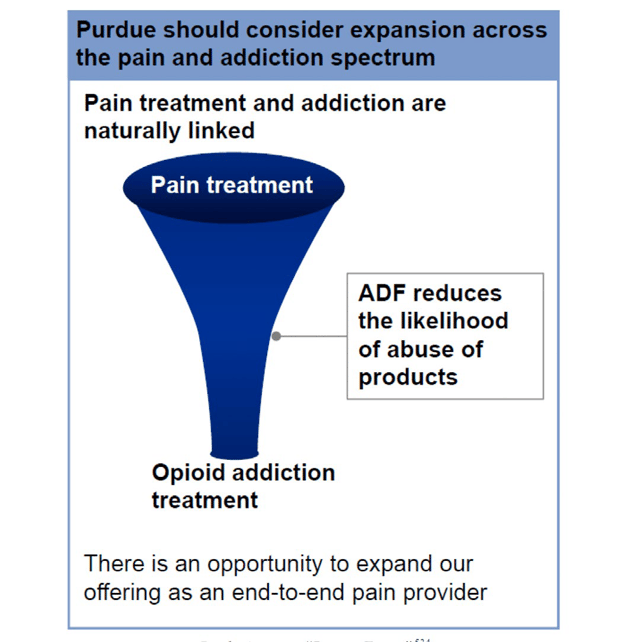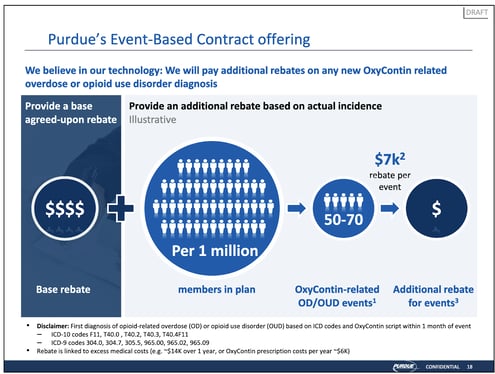
How Euphemistic Corporate Language Aided Purdue Pharma’s Role in the Opioid Crisis
Corporate jargon is full of empty phrases and endless metaphors. But lurking underneath is the dark reality of how this language facilitates corporate profits at the cost of human lives.
For four years, I worked as a strategy consultant helping healthcare organizations to analyze their service lines and reach more patients. Working at this job required becoming proficient in a kind of language we might call the “corporate dialect.” Often, fellow consultants would use phrases that sounded vivid, exciting, and meaningful but that turned out to express only the most banal ideas.
When my manager suggested that our presentation include “a deep dive on competitors,” it struck me as quite profound: a deep dive! There are depths to plumb! We are wet-suited and oxygen-tanked, intrepid Jacques Cousteaus conducting revolutionary explorations 300 feet under the sea.
It turned out that “a deep dive on competitors” just meant, “put together a slide with some facts about our competitors”— and maybe include a box with some giant numerals, like the year they were founded or how many kinds of diabetes tests they make.
The first time I heard someone mention “best practices,” I was very impressed. We had actually tested all the ways to organize our files and determined that a nine-folder structure leads to the best data management? I was disappointed to learn that “best practice” meant, at most, “generally effective practice”—and usually just “the way everyone does it.”
Ludwig Wittgenstein, writing in his 1953 Philosophical Investigations, decries language that “goes on holiday,” words that fill space or pass the time without actually making themselves useful. It’s a critique intended for his fellow philosophers. But he might have been speaking directly to the corporate world. In a consultant’s hands, “deep dive,” a term accustomed to describing actual depth and actual diving, gets to take a little break: to sun itself on the beach and think about superficial things. “Best practices,” a phrase which ordinarily describes the practices that are best, finally breaks free from its perfectionism and refers to whatever practices it likes, without worrying about data or research or the scientific method.
But “language on holiday” isn’t just a preoccupation of former literature majors like me. Consultants’ corporate jargon has a tangible impact on the companies they advise. And that impact comes, in part, from the vacuity of the language.
Consider a pamphlet from my former company describing their approach to mergers and acquisitions (M&A). “The more a company flexes its M&A muscle,” the pamphlet promises, “the better it becomes at incorporating best practices and institutionalizing M&A excellence.” It’s a visually-appealing document: bold text overlays a high-resolution photograph of a suspension bridge; minimalist icons accentuate punchy bullet points; large numerals attest to the company’s record of success.


There are also several metaphors on display. The bridge suggests a “journey” theme, furthered by phrases in the body text like “illuminates the path,” “clears the path,” and “speeds you on the path.” But the illuminated path is represented by a fancy diamond (because jewelry gives clear vision?) and the cleared path is designated by a chain link—which evokes connectivity, but has nothing to do with path-navigation.
“We utilized a strong M&A framework to build our M&A engine,” the text tells us. Moments later we learn that “M&A has truly become a business muscle.” As a company “flexes its M&A muscle,” the document continues, it is “essentially creating an ‘M&A factory.’” You may not have realized that engines could truly become muscles or that you could flex your muscles to create a factory.
By following this approach to M&A, the document concludes, we are “building a strong foundation for future growth.” Part of what makes foundations strong, though, is the fact that nothing grows in them. They are made of bio-resistant concrete. If you want to grow something, I’d suggest more porous, organic materials. Dirt, maybe.
In one sense, this is exactly what Wittgenstein was talking about: language has “gone on holiday.” Words have been removed from their usual contexts and combined into bullet points that have nothing to do with foundations, muscles, or factories as we typically understand them. But here’s the funny thing—this document was written by people who really are experts in M&A. They’ve produced billions of dollars of revenue by helping companies merge and acquire. And the bridge-diamond-factory is part of their approach.

How could such a mix of metaphors contribute to a successful merger or acquisition? Why talk about foundations and muscles when such things are nowhere in sight? Wittgenstein is quite helpful here. Words aren’t merely labels: that’s one of his main points in the Philosophical Investigations. We use language to do things, not just to refer to things. If we only read for referential meaning, the M&A document is vapid, metaphors crumbling at the slightest touch. But meaning is use, Wittgenstein tells us. To understand the document, we need to pay attention to what language does here.
Corporate jargon is less empty than it seems. In fact, it’s a fundamental part of what consulting firms are selling. In the M&A document, all those mixed metaphors create an impressionistic word cloud of reassuring images—and this renders mergers and acquisitions much more appealing than they would otherwise be. It’s far more pleasant to think about muscles and bridges than the actual practicalities of M&A: transferring payroll, combining offices, deciding which employees to keep and which to lay off.
Corporate language is absurd, but it’s still doing work. We need to pay attention to whether it’s work we want done— because the consequences can be devastating. We can see the impact of business jargon in one of the worst public health crises in modern times: the opioid epidemic.
Even before the coronavirus pandemic, U.S. life expectancy was declining, in part due to deaths of despair from drug overdoses, alcoholism, and suicide. The opioid epidemic has continued to worsen; deaths from overdoses rose in 2021. According to government statistics, in the past year, over a million Americans had an “opioid use disorder” (what we think of as dependency or addiction) and 10 million Americans misused prescription opioids.
Between 2004 and 2019, Purdue Pharmaceuticals worked with the consulting firm McKinsey & Company to address lagging sales of their most profitable drug, OxyContin, a highly addictive, semisynthetic opioid designed to treat chronic pain. McKinsey’s advice did increase sales—through deceptive marketing tactics that pressed physicians to prescribe higher doses of opioids over longer periods while also misleading physicians about the danger of addiction, overdose, and death. The Massachusetts Attorney General found that staying on prescription opioids for 90 days makes you 30 times more likely to die of an overdose. Implementing McKinsey’s tactics, Purdue saw the number of these long-term OxyContin users grow by 60 percent.
Again acting on McKinsey’s advice, Purdue targeted physicians who had not received training in the risks associated with opioids and focused on vulnerable patient populations such as veterans and the elderly. As the New York Times put it in 2007, Purdue enacted “the most aggressive marketing campaign ever undertaken by a pharmaceutical company for a narcotic painkiller.” By 2010, sales of OxyContin had tripled, producing $3 billion in revenue per year, and continuing to grow through 2013.
What role did corporate language play in that project? Such language is certainly on full display in McKinsey’s work for Purdue. A 2014 McKinsey presentation suggests that Purdue try its hand at addiction treatment: “Purdue should consider expansion across the pain and addiction spectrum.”

Source: Purdue Pharma/Suffolk County Superior Court via CNN
The accompanying illustration depicts not a spectrum (surprise!) but a funnel, beginning at “Pain treatment” and ending with “Opioid addiction treatment.” The maker of the slide seems not to have considered the way that funnels actually work: everything you put into a funnel comes out of it at the other end. In this model, then, everyone who starts as an OxyContin user becomes addicted to the drug. Thankfully, this is not the case. (Still, the effect is substantial: a 2015 National Institutes of Health study of opioid prescriptions showed a 21-29 percent rate of misuse and an 8-12 percent rate of addiction.)
So what’s the funnel doing here? Is this a case of language on holiday? In one sense, yes: the words (and symbols) on this slide are not doing their usual job. If you try to understand the slide by thinking about a spectrum or picturing how funnels actually operate, it doesn’t make sense. But that’s actually part of the work that language is doing here: it’s resisting our critical attention. Move along now, the slide is saying. Don’t think about any of this too carefully. In other words: don’t think about whether there’s a spectrum or a funnel. Don’t think about whether the funnel should be a filter. And definitely don’t think about the fact that the “products” in question are dangerously high doses of aggressively marketed narcotics.
“There is an opportunity,” the slide concludes, “to expand our offering as an end-to-end pain provider.” This is a nice description: it makes patients’ relationship to Purdue sound comprehensive and seamless. Of course, it’s seamless because Purdue is creating the demand they plan to meet. They’ll be there when you need pain medication, and they’ll be there later when you’re addicted to it. “End-to-end” seems so helpful to customers, so savvy as a business strategy, that it’s easy to forget there’s a literal end involved. In 2014, the year McKinsey presented this slide, over 28,000 people died in overdoses involving opioids. By 2021, that number had increased to over 80,000.
In 2017, the Health and Human Services director declared the opioid crisis a public health emergency. But McKinsey didn’t let up. In December of that year, they gave a presentation that proposed a way to increase sales to wary pharmacies: whenever a patient overdosed on OxyContin, the pharmacy that had provided the drug to the patient would receive a financial rebate.
The presentation never puts it this plainly, though. It promises “innovative contracts” to address “market access challenges,” recommending that Purdue offer rebates on a “per-event” basis. It takes 15 slides before the viewer learns that these “events” are overdoses. (For every use of the word “overdose,” the word “event” appears five times.) And the presentation never acknowledges that “market access challenges” stem from nothing less than the opioid crisis itself. Purdue faced new barriers to selling OxyContin because physicians and legislators had recognized the drug’s role in fueling addiction.

Source: McKinsey “Innovative Contracts”
McKinsey’s 2017 guidance recommends “event”-based contracts as a way to target overdoses. The word “target” conjures up the image of opioid addiction with a bullseye on its back, as if McKinsey’s energy were directed toward the overdoses themselves, aiming to reduce their number. But that phrasing obscures what McKinsey is actually proposing here: that Purdue would respond to the financial impact of opioid use disorder by mitigating the monetary risk those cases pose to the company itself. Overdose and addiction make pharmacies less willing to sell OxyContin and physicians less willing to prescribe it; they also make Purdue more vulnerable to litigation. These are the concerns that the proposal aims to address, not human suffering or the company’s role in producing it.
McKinsey calls this “innovative contracting.” Innovative because the contract puts a company’s interest before that of its consumers? Innovative because they’ve found a way to sell more opioids to people who are dependent on them? Innovation, welcome to the holiday of a lifetime.
Except it’s not just a holiday. The word is still doing work, even if it’s not its usual job. Corporate jargon facilitates profit by obscuring human impact. By forgoing the language of overdose in favor of corporate speak, McKinsey makes it possible to avoid talking about deaths as deaths. “$7k rebate per event,” one slide suggests; a footnote adds that a $14,000 rebate would cover “excess medical costs.” The excess costs aren’t listed. That means we don’t have to think about the expenses that prompt the rebate in the first place. Cost of naloxone. Cost of ambulance ride. Cost of rehab, cost of therapy, cost of methadone. Cost of relapse. Cost of death.
Instead, the presentation turns “excess medical costs” into a footnote. When we don’t talk about what the costs are, we can imagine there’s nothing to say.
Would explicit language have made a difference to executives bent on selling more OxyContin? The consultant who made the 2017 presentation presumably looked at the costs included in that $14,000. But the slides still reflect a single-minded pursuit of profit. We also know that Purdue was aware of the testimonies delivered by anguished mothers and fathers who lost children to opioids, because they drafted materials to use in response. McKinsey’s corporate obfuscations hid a truth that executives already knew.

But imagine a presentation that replaces every use of the word “event”—all 56 of them—with “person seriously ill or dead from OxyContin.” And instead of saying that the contracting model “targets overdose,” what if the presentation explained that the new contracts increase overdoses but target the overdose-related loss of sales? It’s possible the people listening to the presentation wouldn’t have minded. But it might have forced them to pay attention to the moral weight of the issue, or at least recognize that others would condemn their approach. After reading a distraught mother’s testimonial, one Purdue executive acknowledged, “I see a liability here”—a heartless response that at least suggests some recognition of the problem. But amidst the language of funnels and innovations, it’s hard to see anything except “opportunity” and “attractive options.”

Corporate language didn’t cause Purdue’s wrongdoing, but it aided and abetted it. McKinsey’s presentations made it possible to ignore grisly details and unsettling testimony—and possible to discuss the opioid crisis without referring to their active incitement of it. Corporate speak helped McKinsey pursue their central goal: profit. An anonymous former McKinsey consultant, writing in 2019, put it this way:
“McKinsey has done direct harm to the world in ways that, thanks to its lack of final decision-making power, are hard to measure and, thanks to its intense secrecy, are hard to know. The firm’s willingness to work with … corrupt business empires is the logical conclusion of seeking profit at all costs. Its advocacy of the primacy of the market has made … businesses more like vampires.”
McKinsey’s work with Purdue makes their direct harm unusually clear. Corporate language facilitated a profitable but devastating business strategy: the deceptive marketing of high doses of dangerously addictive opioids to the least-informed physicians and most vulnerable patients.

Words don’t just mean. They act. McKinsey’s corporate jargon reduces real deaths to banal phrases. The firm’s presentations instrumentalize lives for profit, turning addiction into “opportunity” and using metaphors that erase overdose. But for the people harmed by McKinsey and Purdue, addiction, overdose, and death aren’t erasable. In one mother’s letter to Purdue—published in the Massachusetts Attorney General’s filing against Purdue and its leadership—we see frank pain:
“My son was only 28 years old when he died from Oxycontin on New Year’s Day. We all miss him very much, his wife especially on Valentine’s Day. Why would a company make a product that strong (80 and 160 mg) when they know they will kill young people? My son had a bad back and could have taken Motrin but his Dr. started him on Vicodin then Oxycontin then Oxycontin SR. Now he is dead!”
Why would a company make a product so strong—OxyContin SR is typically reserved for patients with cancer pain— and market it to people who could easily become addicted to the medicine and even die? Corporate jargon doesn’t have the language to ask this question. It lets executives flee to a world of “events,” “treatment,” and tripled sales. Purdue worked to reframe overdose testimonials because they didn’t want their drugs’ effects described in such blunt and devastating terms. But we can use the language they’re afraid of. We can name the deep anguish, the human cost, caused by McKinsey and Purdue. Legal filings have begun to do this. In 2021, 49 states made claims against both firms, describing the tangible impact of the financial “opportunities” McKinsey and Purdue so doggedly pursued. As recently as September 2022, new lawsuits challenged McKinsey’s role in the opioid crisis.
Holding these companies responsible for their actions means, in part, rejecting the terms in which they describe those actions. It also means seeing their descriptions as part of their actions: words that seem benign and absurd but facilitate real harm. Corporate language makes it possible to pursue profit at the expense of real people—but we can demand words that don’t look away. We can insist on language that recognizes suffering. Only then can we work to alleviate it.




